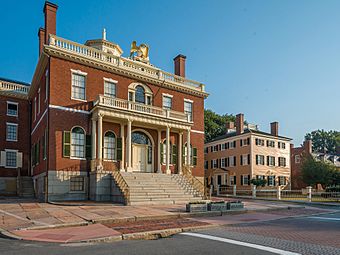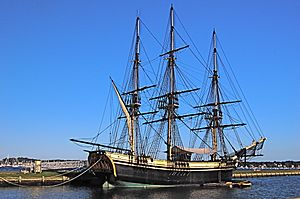Salem Maritime National Historic Site facts for kids
|
Salem Maritime National Historic Site
|
|

Salem Custom House (1819)
|
|
| Location | Essex County, Massachusetts, USA |
|---|---|
| Nearest city | Salem, Massachusetts |
| Area | 9 acres (0.036 km2) |
| Visitation | 676,216 (2005) |
| Website | Salem Maritime National Historic Site |
| NRHP reference No. | 66000048 |
Quick facts for kids Significant dates |
|
| Added to NRHP | September 1, 1976 |
| Designated NHS | March 17, 1938 |
The Salem Maritime National Historic Site is a special place in Salem, Massachusetts. It's the very first National Historic Site ever created in the United States, back on March 17, 1938.
This site helps us learn about Salem's important history with the sea. It shows how people traded goods like cotton, rum, and sugar long ago. It also tells stories about brave privateers during the American Revolution, who were like licensed sailors helping fight for independence. The site also teaches about global trade with places like the Far East after America became independent.
The site covers about 9 acres (36,000 m2) along the waterfront of Salem Harbor. It has 12 old buildings and a cool replica of a tall ship. The National Park Service takes care of this historic site and a visitor center in downtown Salem. The National Park Service is part of the United States government.
In 2012, over 756,000 people visited Salem Maritime. They spent about $40 million, which helped the local area. The National Park Service celebrated its 100th birthday in 2016.
Contents
Historic Buildings and Ships
The Salem Maritime National Historic Site protects and explains many important things from the past. These include old buildings, collections of items, and a replica ship.
Derby House
The Derby House was built in 1762. Captain Richard Derby built it as a wedding gift for his son, Elias Hasket Derby. It's a great example of Georgian style architecture. Elias Hasket Derby was known as the first millionaire in the New World.
Derby Wharf
Derby Wharf was also built in 1762 and made longer in 1806. It's Salem's longest wharf, stretching almost half a mile. When it was busy, warehouses filled with goods from all over the world lined the wharf. The Derby Wharf Light (1871) still stands at the end of the wharf today.
Friendship of Salem Ship
The Friendship of Salem is a copy of a real ship from 1797. This type of ship was called an East Indiaman. The new ship was built in New York in 2000. It now works as a museum ship. The original Friendship sailed 15 times to places like India, China, South America, and Europe. British forces captured the original ship in 1812 during the War of 1812.
Hawkes House
The Hawkes House was designed by a famous Salem architect named Samuel McIntire. Building started in 1780. Benjamin Hawkes bought the unfinished house and finished it around 1800.
Narbonne House
The Narbonne House has parts that date back to 1675. A butcher named Thomas Ives built the part with the high peaked roof. Later, he added more sections. From 1750 to 1780, Captain Joseph Hodges owned the house. In 1780, a tanner named Jonathan Andrew bought it. His family lived there until 1964, when the house was sold to the National Park Service.
Pedrick Store House
The Pedrick Store House is a three-story building from around 1770. It was used for making and repairing ship rigging and sails. It was moved to the Salem Maritime National Historic Site from Marblehead, Massachusetts, in 2007.
Salem Custom House
The Salem Custom House was built in 1819. It was the 13th Custom House in Salem; the first was built in 1649. This is where taxes were collected on goods brought into the country by ship. The famous writer Nathaniel Hawthorne wrote about the eagle on top of the Custom House in his book The Scarlet Letter. A woodcarver named Joseph True carved the eagle.
St. Joseph Hall
St. Joseph Hall was built in 1909. It was the first home of The St. Joseph Society, a group started in 1897 by Polish immigrants. The first floor was rented out to help pay for the building. The large hall on the second floor hosted many weddings, dances, and plays for the Polish community. On the top floor, there were apartments for new immigrants until they could find their own homes. This building now serves as the park headquarters.
West India Goods Store
The West India Goods Store was built around 1804 by Captain Henry Prince. It was probably first used as a warehouse for goods from the East Indies, like pepper, coffee, and tortoise shells. By 1836, Charles Dexter had a shop here. It was one of many stores that sold things people needed for their homes, such as candles, oils, and clothing. It also sold imported goods and luxuries from Europe, Asia, and Africa. The store continued to operate throughout the 1800s.
Gallery
-
Custom House seen from the deck of the Friendship of Salem
Nearby Historic Areas
Just a short walk from the Salem Maritime National Historic Site, you can find other historic areas. These include the Chestnut Street District, Federal Street District, Downtown Salem District, and the Salem Common Historic District.
Images for kids
See also
 In Spanish: Sitio histórico nacional marítimo de Salem para niños
In Spanish: Sitio histórico nacional marítimo de Salem para niños















